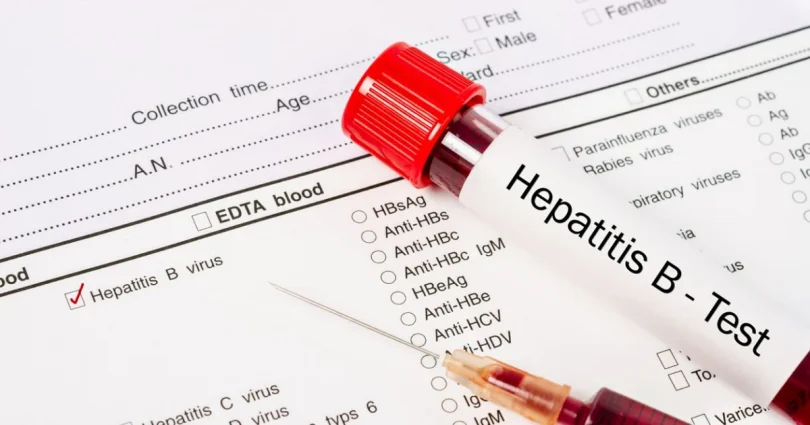This test inspects your blood for hepatitis B surface antigens. The HBsAg blood test determines whether you have had a recent or ongoing hepatitis B virus infection (HBV).
HBV has proteins on its surface known as antigens, which trigger the immune system to produce antibodies. Your blood can contain hepatitis B surface antigens a few weeks after the infection appears. They are one of the earliest indications of a hepatitis B infection.
HBV is one of the five hepatitis viruses. Hepatitis A, C, D, and E make up the other four and are the causes of most hepatitis infections. Blood, seminal fluid, and vaginal secretions are all the ways HBV can be transmitted. After contracting hepatitis B, symptoms may not appear for several months. In most cases, the virus infects the liver, causing an infection.
This virus typically goes away within six months. However, the virus persists in a small percentage of adults and a larger percentage of children. For newborns, this is especially true. It could result in liver cancer, cirrhosis, scarring, or damage to the liver cells.
Hepatitis B surface antigens are a byproduct of chronic or long-term infection and a precursor to acute illness.
Purpose
If the doctor thinks you have an HBV-related liver infection, you might opt this test from the best medical laboratory. If you have hepatitis B symptoms, you might require this test. Most symptoms develop gradually. Many people feel like they have mild flu or no symptoms at all. You might not have any symptoms unless the illness is severe or pervasive. The most common symptom is extreme tiredness. Other signs can include:
- Fever
- Nausea
- Muscle aches
- Loss of appetite
- Dark-colored urine
- Belly (abdominal) pain
- Yellowed skin and eyes (jaundice)
It is advised by your health practitioners to have this test. If you have a medical history that puts you at risk of contracting the virus. Hepatitis B infection risk factors include:
- Having sex with a virus-carrying person
- having close contact with an infected person
- Being a kid born to a virus-carrying mother
- Injecting drugs intravenously (iv) while sharing needles
- Working in a hospital where patients may be exposed to blood
- Receiving an organ transplant or blood transfusion. With active screening, this occurs less frequently.
- If you’ve already received a hepatitis b diagnosis, you might also undergo this test numerous times to determine whether your infection is improving.
Preparation
You don’t have to study for this exam. Ensure all medications, herbs, vitamins, and supplements are disclosed to your healthcare professional. This includes any over-the-counter medications and other illicit substances you may use.
Procedure
During the test, a phlebotomist will insert a small needle to draw blood from a vein in your arm. First, a tourniquet (elastic band) is tightly fastened to the upper arm before drawing blood. Next, the patient is told to tighten their fist. This aids in the accumulation of blood in the veins, making it easier to collect blood.
Before placing the needle in the vein, the skin is cleansed to avoid the passage of microorganisms. Following the needle insertion into the arm’s vein, the container is used to collect the blood sample. The needle may sting slightly when it enters or exits your body. Usually, this takes less than five minutes.
A blood test with a needle carries a few minimal risks. These include bruising, bleeding, and infections. You may feel a mild sting or pain when the needle pierces your arm or hand. The place may become sore afterward, but it soon goes away.
Understanding the Results
Test results may vary depending on age, gender, medical history, and other factors. Depending on the laboratory utilized, your test results could change. They could not indicate a problem with you. Find out what your test findings signify for you by asking your healthcare provider.
Negative or nonreactive results suggest no hepatitis B surface antigen present.
Your HBV infection may be active if your positive or reactive test results. This typically signifies that your recovery will take six months. If you get better, you’ll be immune to the virus and be unable to spread it to other people. You can also have a chronic hepatitis B infection if the test comes positive. The virus may remain in your blood and create liver issues if you don’t get better in 6 months. Others may contract your illness. If you don’t feel better after six months, your doctor might prescribe medication.
The Final Word
Hepatitis B surface antigen (HbsAg test) is an easily recognized serological marker of acute or chronic hepatitis B infection. The initial antigen after HBV infection is HBsAg, typically found 1 to 10 weeks after the onset of clinical symptoms. To identify whether an infection has cleared up or the patient has become a chronic carrier of the virus, HBsAg testing is frequently used to diagnose suspected HBV infection.






